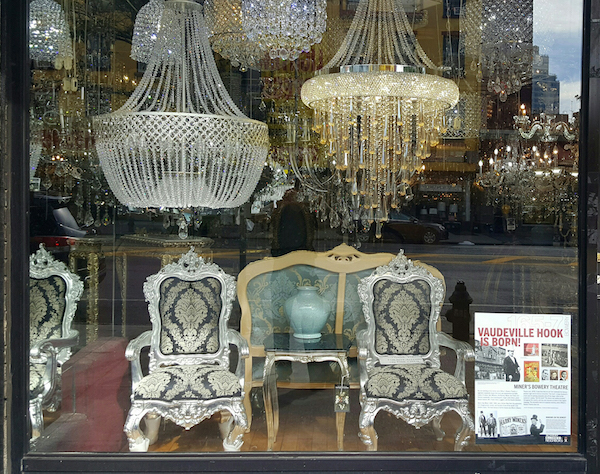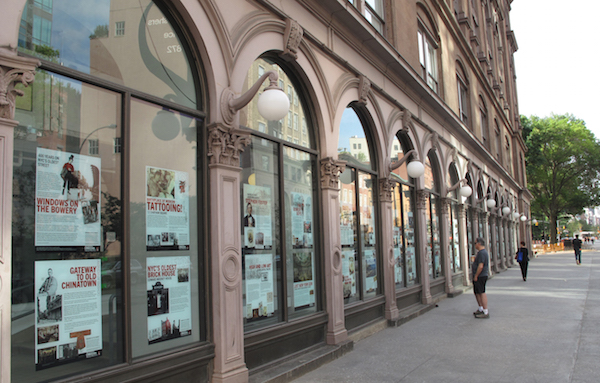
BY TRAV S.D. | New York’s Bowery has got to be near the top of the list of streets with the greatest name recognition in the world. Once New York’s main entertainment and amusement stem, later its Skid Row, it is as much a part of folklore as it is a part of history. Sadly, most of the Bowery’s storied past has been demolished, built over, or unrecognizably altered. Leading the charge to preserve what is left — and to remind the public how it used to be — is the Bowery Alliance of Neighbors.
On July 5, the not-for-profit organization officially launched a project designed to be bring this history before the public.
“Windows on the Bowery” consists of a series of 64 placards, each of which gives the history of a different Bowery address. In addition to being hung at the actual addresses, the colorful and descriptive posters will also be hung gallery-style in exhibitions at the Cooper Union Foundation Building at Astor Place and Cooper Square, and at the historic HSBC Bank building at the Bowery and Canal St. Full disclosure: two of the panels (the ones on Miner’s Bowery Theatre and the Tony Pastor Opera House) were written by this correspondent — but I’m in good company. Among the others are the well-known Irish-American folklorist and musician Mick Moloney; David Freeland, author of “Automats, Taxi Dancers and Vaudeville;” Eric Ferrara, author and director of the Lower East Side History Project; architectural author, historian, and consultant Kerri Culhane, of Two Bridges Neighborhood Council; and 13 others.
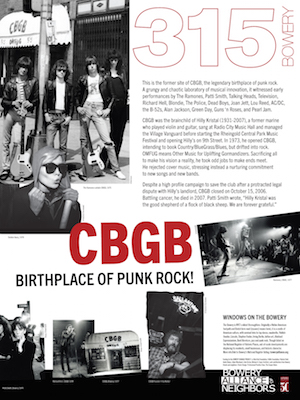
The Project Director and Editor is David Mulkins, Founder and Director of the Bowery Alliance of Neighbors. “We got the idea for this project six or seven years ago,” says Mulkins. “It was the natural follow-up to our getting the Bowery listed on the National Registry of Historic Places, which we accomplished with the help of Two Bridges Historical Council.”
One doesn’t have to spend much time with these posters before becoming overwhelmed with the enormity of how important the Bowery is to New York’s — and America’s — culture. A festival atmosphere pervades; the sum of the experience gives you a feeling that the street was sort of like Coney Island without the rides. Dime museums, theatres, vaudeville houses, saloons, boxing venues, hotels, social clubs, and even a zoo, have graced the street. Too many birthplaces to count: the first modern tattoo parlor, the first exhibition by P.T. Barnum, and even the first punk rock club (the Bowery continues to be influential and innovative into modern times). A large part of conveying that wonder is the impact made by the visuals, which were created by the graphic design staff and students of Cooper Union, led by professor Mindy Lang.
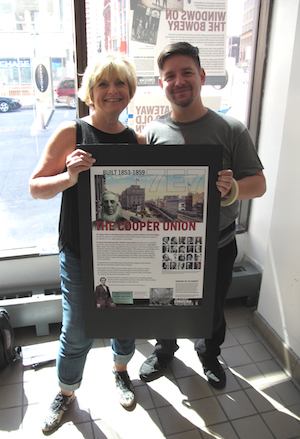
“They were awesome,” Mulkins gushes. “We kept adding additional work as the project progressed and they were like, ‘Bring it on!’ They’re the ones who got the idea for the display component at Cooper Union. It took a lot of people to pull this off.”
Mulkins also cites the generosity of the many institutions and private collectors who contributed the gorgeous historical visuals that are vital to these hangings. Among those he mentions are the New York Public Library and the Harvard Theatre Collection, as well as collector Adam Woodward.
“[Woodward] has this amazing collection of images and ephemera, material which has largely been unseen. We found this poster for Owney Geoghegan’s Boxing Saloon. On the list of talent the poster advertises is a then-unknown John L. Sullivan.”
Also incorporated are works by living photographers. 92-year-old Erika Stone contributed photos of Sammy’s Bowery Follies, the tourist theme bar which was a going concern as late as 1970. And there are photos of CBGB by Godlis, Bob Gruen, and Stephanie Chernikowski.
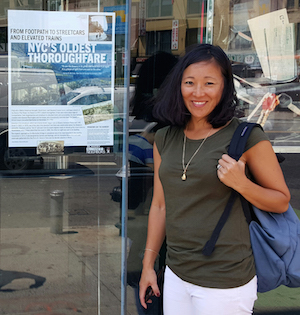
What is it about the Bowery?
Mulkins, who taught high school history for 25 years, offers his own explanation: “I’ve always been attracted to the history of suppressed or forgotten people. Bowery has this seminal connection to that. It was this multicultural nexus. So many groups made early contributions here: African Americans, Irish, Chinese, Italians, the Yiddish theatre. It’s New York City’s oldest street. It’s been an incubator for so many culturally important innovations, and a home to so many of its innovators: tap dance, vaudeville, Stephen Foster, Irving Berlin, jazz, beat literature, the first pro baseball club, punk rock, Lincoln’s anti-slavery speech at Cooper Union. John Brown’s body was prepared for burial here. The Globe Dime Museum, where Houdini gave his first solo public appearance, was here. Sophie Tucker, Al Jolson, and Eddie Cantor all got their starts here. The Bowery story contains so many issues, events, and influences — with equal merit — we couldn’t include them all. We kept adding, but this project only scratches the surface.”
But it’s mighty impressive nonetheless!
For more information, visit: boweryalliance.org/windows-on-the-bowery.
